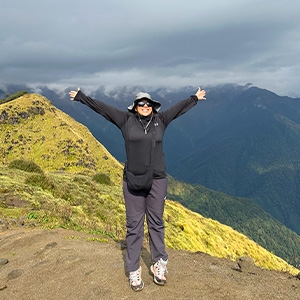Do we need a trek permit for trekking in Nepal?
Yes, you need a particular region permit for trekking in Nepal. Although the permits vary by location, a licensed trekking agency can arrange all your trekking permits. Normally, we get your permits before you show up. However, it requires your actual passport to get your permits if you're trekking in the Manaslu or Upper Mustang regions of Nepal. We'll include time in your itinerary to arrange your permit when you arrive in Nepal, before your trip begins.
*Please note that Upper Mustang is a highly restricted area and that trekking permits for this area cost $500 (Restricted Area Permit) + $30 (ACAP) per person for a maximum stay of 10 days. Therefore, Treks in this area are substantially more expensive.
What are the consequences of trekking without a permit or a guide in Nepal?
Trekking without a guide or permit is now illegal in Nepal and can cause different consequences like fines, deportation and even imprisonment. Recently, Nepal Tourism Board has announced a ban on independent trekking for tourists in Nepal and has mandated hiring a licensed guide or a porter. This rule is specially implemented to ensure the safety of the trekkers in the high altitude and protected regions of Nepal. Therefore it is mandatory to obtain the necessary permits and follow the regulations of the regions to avoid any legal consequences while trekking in Nepal.
Where can I get a trek permit in Nepal?
There are different places where you can easily obtain the trekking permits in Nepal. You can purchase the entry permits at the entrance for any National Parks. However, for trekking permits you need to purchase them from the Nepal Tourism Office at Kathmandu or in Pokhara. You can also obtain the trekking permits from the Department of Immigration, Kathmandu or Pokhara. You can also obtain trekking permits from the Trekking Agencies Association of Nepal (TAAN) or from the ACAP (Annapurna Conservation Area Project) office in Pokhara. Likewise, some trekking routes like Upper Mustang, Everest Region require special area permits like Khumbu Pasang Lhamu Rural Municipality Permits or a TIMS card. It is highly recommended to obtain your permits through a licensed trekking agency to ensure that all the necessary permits are obtained for your safety throughout the trek.
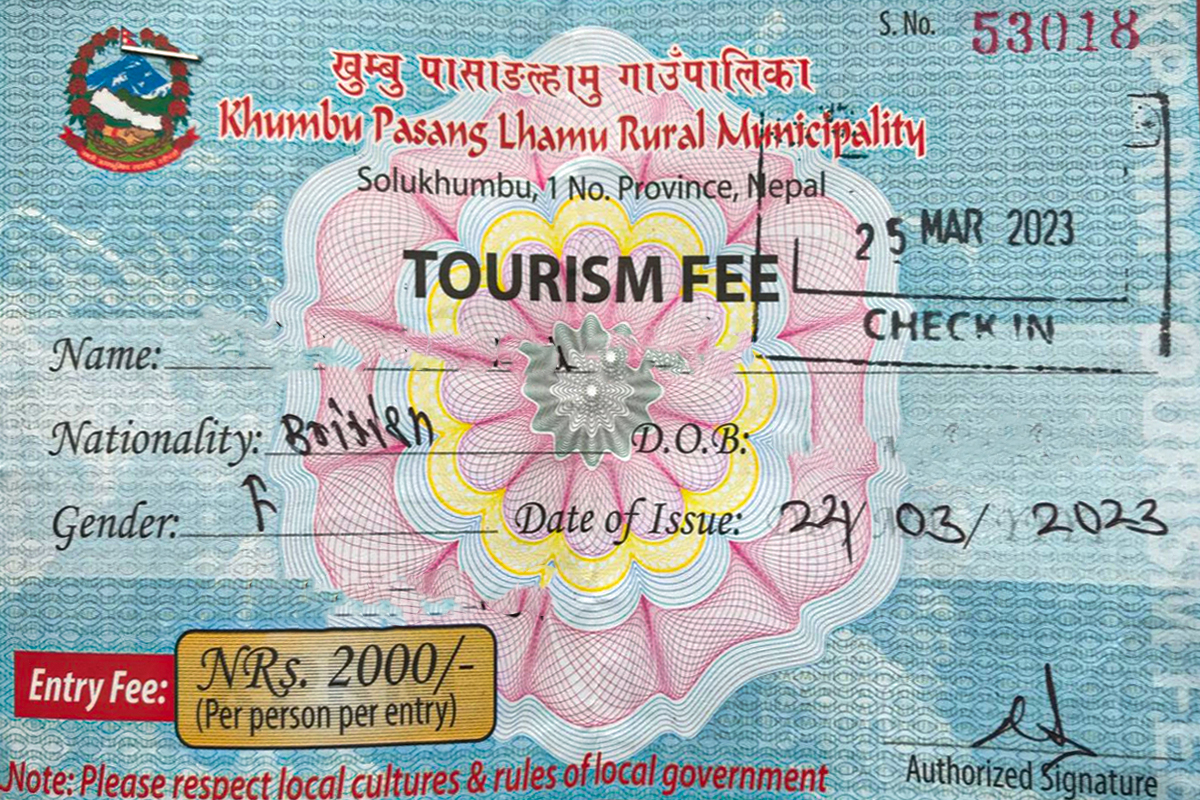
Why do we need a trekking permit for trekking in Nepal?
Trekking permits are now compulsory in Nepal. The permits are important to ensure the safety of the trekkers along with the conservation and protection of the environment and culture of the areas being explored. Different regions require different types of permits such as the TIMS ( Trekkers Information Management System), Conservation Area Permits, Restricted Area Permits. As the permits vary through regions, the fees for these permits also vary depending on the region and the duration of your trek. The permits obtained help to keep track of the movement of trekkers which is very essential in case of emergencies. It also helps to control the number of trekkers in the particular area to prevent overcrowding and also environmental damage. The permit fees also contribute to the conservation and development of the trekking areas.
The permits can be obtained from the Department of Immigration, Kathmandu or it would be easy if you book a trek from a local trekking agency who will take care of all your required trekking permits. However, it is highly advised to hire a guide/ porter and get all your required permits to prevent legal consequences.
Types of Permits for Trekking in Nepal
TIMS Card
The Trekkers' Information Management System (TIMS) card is an essential permit requirement for all foreign trekkers who intend to trek in the Himalayas of Nepal. The Nepal Tourism Board and the Trekking Agencies Association of Nepal (TAAN) implemented TIMS in 2010 to ensure the safety and security of trekkers, monitor their movements in the region, and manage the number of trekkers entering Nepal's trekking districts. The TIMS card contains the details of the trekker, nationality, passport number, and route used, in order to track their movements throughout the trek. All trekkers, both those who trek independently and those who walk with a guide or porter, require a TIMS card. The TIMS card costs you USD 20 per person which includes a single entry into a particular restricted area. Once issued, the permit cannot be returned or extended and is not transferable.
(Solo trekking or Free Individual Trekking in Nepal is now banned in order to ensure the safety and security risks of the trekkers in the protected areas of Nepal. According to NTB, you must hire a guide or a porter and obtain a TIMS Card in order to trek in the restricted and protected areas of Nepal.)
The Nepal Tourism Board or TAAN both offer the TIMS card. To receive the TIMS card, trekkers must provide a copy of their passport, visa, and two passport-sized pictures. The TIMS card is not the same as the other permits necessary for trekking in particular areas, such as the Langtang National Park Permit, the Sagarmatha National Park Permit, and the Annapurna Conservation Area Permit (ACAP) (LNPP). Trekkers must therefore get both the TIMS card and the required permits for the particular trekking region they intend to visit. Overall, TIMS cards are essential permits that each and every international trekker needs to acquire before beginning a trek in Nepal. It controls the number of trekkers entering Nepal's trekking districts and aids in ensuring trekkers' safety. To prevent any legal problems or penalties, you must obtain the TIMS card before starting your trek.
TIMS Permit fees for
- Foreigners: NRs. 2,000 per person
- SAARC countries: NRs. 1,000 per person
Note: Any trekkers caught using permitted trekking paths without a licensed guide/ porter or TIMS card can face a Rs 12,000 fine.
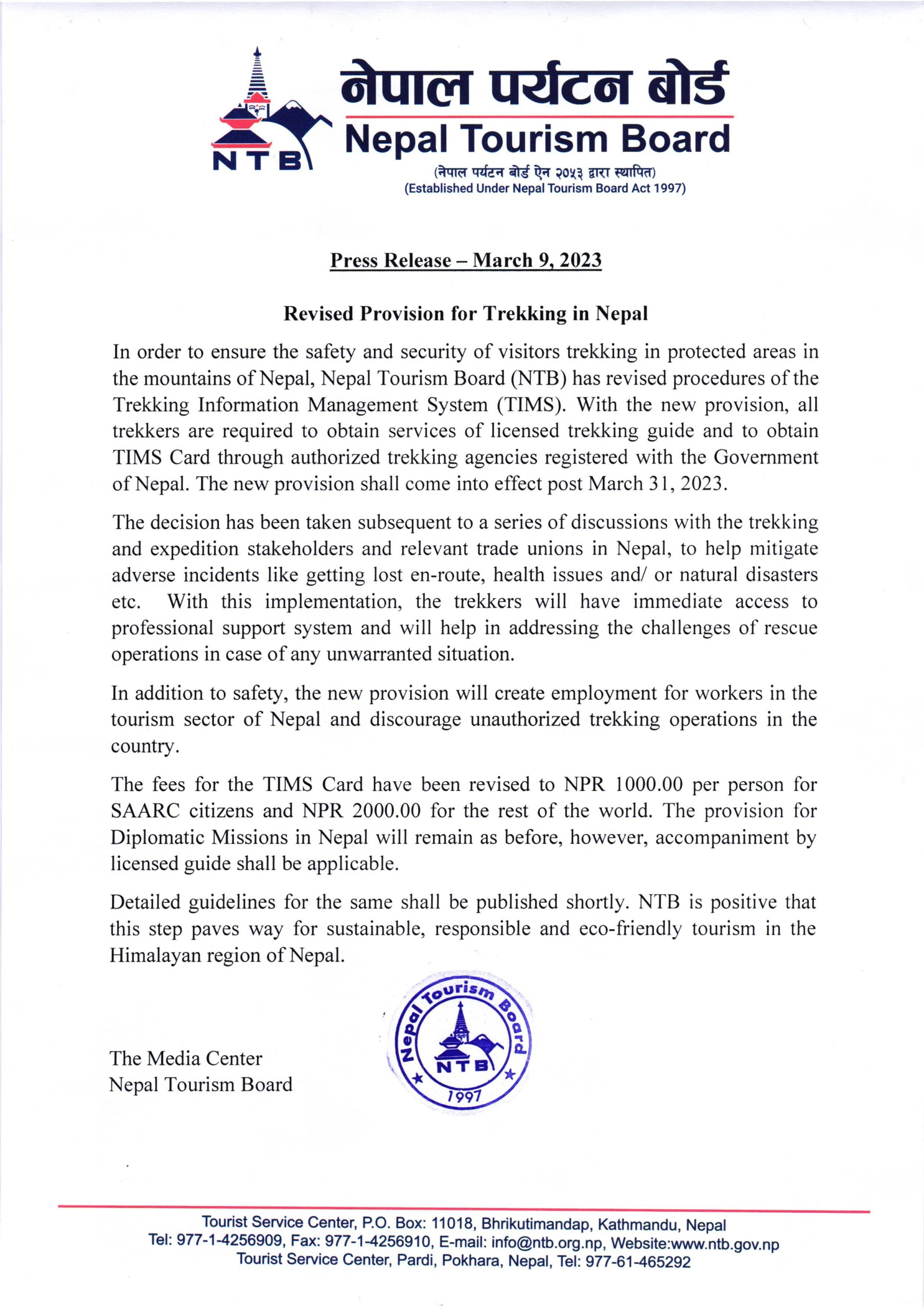
National Park Permit
The National Park Permit is another important permit that allows trekkers or visitors to enter and explore the national parks of Nepal. The Department of National Parks and Wildlife Conservation (DNPWC) issues national park permits making it a mandatory permit requirement for all visitors. The permit fee for the national parks varies from USD 10 to USD 35 per person per day depending on the park. In addition to the National Park Permit, visitors may also need to acquire other permits or visas depending on their nationalities and the amount of time their stay in Nepal.
It is recommended to check all the relevant authorities before planning a trip to Nepal to ensure that all the important parameters are obtained in advance.
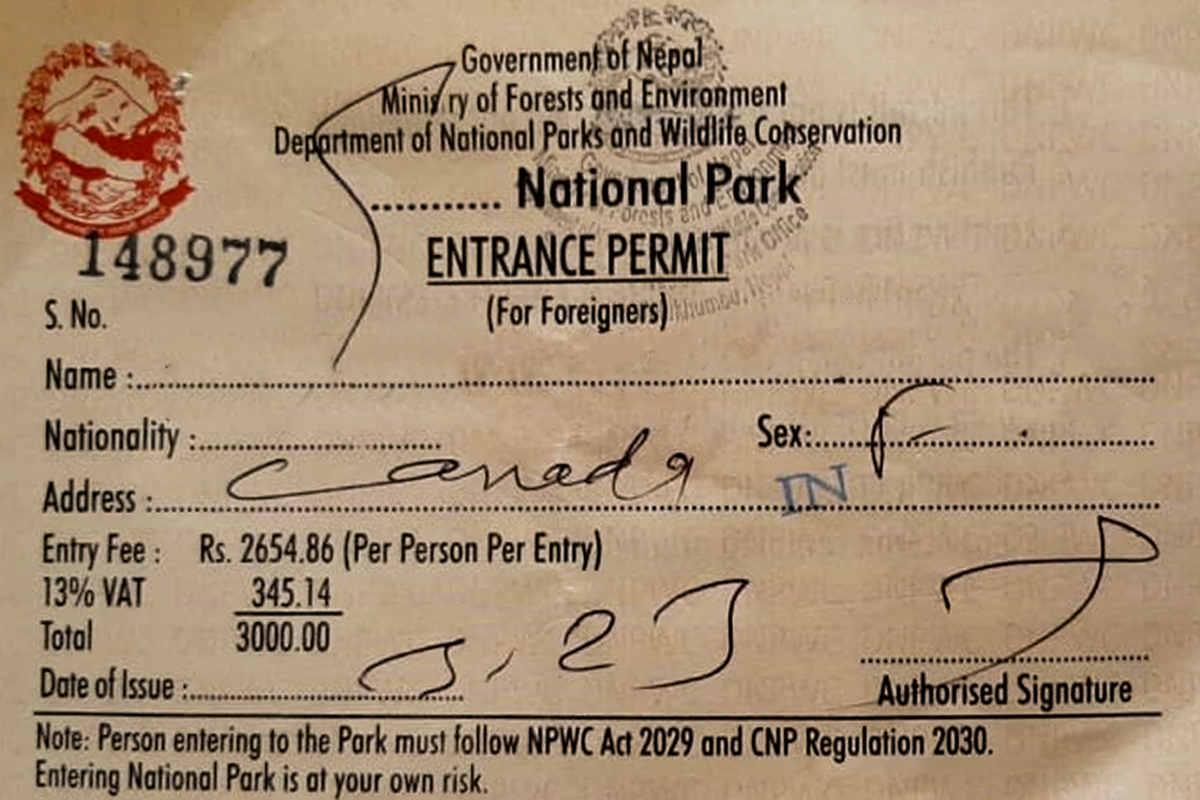
Here is the list of permit fees in the National Parks of Nepal:
S.N. | National Parks/ Wildlife Reserves | Nepali (per person/ per entry) | SAARC (per person/ per entry) | Foreigners (per person/ per entry) | Children Discount |
1. | Chitwan National Park | NRs. 150 | NRs.1,000 | NRs. 2,000 | Free Below 10 yrs old |
2. | Sagarmatha National Park | NRs. 100 | NRs. 1,500 | NRs. 3,000 | Free Below 10 yrs old |
3. | Banke National Park | NRs. 100 | NRs. 750 | NRs. 1,500 | Free Below 10 yrs old |
4. | Bardia National Park | NRs. 100 | NRs. 750 | NRs. 1,500 | Free Below 10 yrs old |
5. | Khaptad National Park | NRs. 100 | NRs. 500 | NRs. 1,500 | Free Below 10 yrs old |
6. | Langtang National Park | NRs. 100 | NRs. 1,500 | NRs. 3,000 | Free Below 10 yrs old |
7. | Makalu-Barun National Park | NRs. 100 | NRs. 1,500 | NRs. 3,000 | Free Below 10 yrs old |
8. | Parsa National Park | NRs. 100 | NRs. 750 | NRs. 1,500 | Free Below 10 yrs old |
9. | Rara National Park | NRs. 100 | NRs. 1,500 | NRs. 3,000 | Free Below 10 yrs old |
10. | Shey-Phoksundo National Park | NRs. 100 | NRs. 1,500 | NRs. 3,000 | Free Below 10 yrs old |
11. | Shivapuri National Park | NRs. 100 | NRs. 600 | NRs. 1,000 | Free Below 10 yrs old |
12. | Shuklaphanta National Park | NRs. 100 | NRs. 750 | NRs. 1,500 | Free Below 10 yrs old |
13. | Dhorpatan Hunting Reserve | NRs. 100 | NRs. 1,500 | NRs. 3,000 | Free Below 10 yrs old |
14. | Koshi Tappu Wildlife Reserve | NRs. 100 | Rs. 750 | NRs. 1,500 | Free Below 10 yrs old |
Restricted Area Trekking Permit (Special Permit)
The restricted areas of Nepal are mainly located in the northern and western parts of the nation, close to the Himalayan mountain range. The Nepali government works to safeguard these regions because they frequently include special natural and cultural resources. Trekking is permitted through these locations, although tourists are required to apply for permits and pay a charge. Depending on the location and duration of the trek, there are different permit fees for trekking in Nepal's restricted areas. Longer stays and more remote or challenging-to-access regions often come with greater prices.
Although trekkers in Nepal are permitted to trek alone or in groups of varying sizes, they can also trek as FITs (Free Individual Trekkers) Solo trekking or Free Individual Trekking in Nepal is now banned in order to ensure the safety and security risks of the trekkers in the protected areas of Nepal. However, there are some trekking areas that are absolutely restricted by the Government of Nepal and are referred to as "Restricted Areas" or "Controlled Areas." Only a registered trekking agency, such as Footprint Adventure can obtain a restricted trekking permit from the Department of Nepal Immigration. The table below contains information about the Restricted Area Permit fees.
S.N. | Restricted Trekking Area | Permit Fee |
1. | Upper Mustang - Lo Manthang Rural Municipality (All areas of ward no. 1 to 5)
- Lo-Gekar Damodar Kunda Rural Municipality (All areas of ward no. 1 to 5)
- Baragung Mukti Chetra Rural Municipality (All areas of ward no. 3 and Satang Village of ward no.5)
| USD 500 per person (for the first 10 days) USD 50 per person /Day ( beyond 10 days) |
2. | Upper Dolpo - Dolpo Buddha Rural Municipality (All areas of ward no. 4 to 6)
- Shey Phoksundo Rural Municipality (All areas of ward no. 1 to 7)
- Charka Tangsong Rural Municipality (All areas of ward no. 1 to 6)
| USD 500 per person (for the first 10 days) USD 50 per person /Day ( beyond 10 days) |
3. | Gorkha Manaslu Area Chumnubri Rural Municipality (All areas of ward nos. 1,2,3 and 4) | September – November USD 100 per person / week USD 15 per person / day (beyond 1 week) December – August USD 75 per person / week USD 10 per person / day (beyond 1 week) |
4. | Humla - Simikot Rural Municipality (All areas of ward nos. 1,6 and 7)
- Namkha Rural Municipality (All areas of ward no. 1 to 6)
- Changkheli Rural Municipality (All areas of ward no. 3 to 5)
| USD 500 per person (for the first 10 days) USD 50 per person /Day ( beyond 10 days) |
5. | Taplejung (Olangchung Gola and Kanchenjunga) - Phantanglung Rural Municipality (All areas of ward nos. 6 and 7)
- Mikwakhola Rural Municipality (All areas of ward no. 5)
- Sirijunga Rural Municipality (All areas of ward no. 8)
| USD 20 per person/ week (for the first 4 weeks) USD 25 per person /week (beyond 4 weeks) |
6. | Lower Dolpo Area - Thuli Bheri municipality (All areas of ward no. 1 to 11)
- Tripurasundari municipality (All areas of ward no. 1 to 11)
- Dolpo Buddha Rural Municipality (All areas of ward no. 1 to 3)
- Shey Phoksundo Rural Municipality (All areas of ward no. 8 and 9)
- Jagdulla Rural Municipality (All areas of ward no. 1 to 6)
- Mudkechula Rural Municipality (All areas of ward no. 1 to 9)
- Kaike Rural Municipality (All areas of ward no. 1 to 7)
| USD 20 per person/ week USD 5 per person /day (beyond 1 week) |
7. | Dolakha (Lapche Valley and Tashi Lapcha Pass) - Gaurishankar Rural Municipality (All areas of ward no. 9)
- Bighu Rural Municipality (All areas of ward no. 1)
| USD 20 per person/ week |
8. | Gorkha Tsum Valley Area - Sirdibas-Lokpa-Chumling-Chekampar-Nile-Chule
- Chumnubri Rural Municipality (All areas of ward nos. 3,6 and 7)
| September – November USD 40 per person / week USD 7 per person / day (beyond 1 week) December – August USD 30 per person / week USD 7 per person / day (beyond 1 week) |
9. | Sankhuwasabha (Makalu Area) - Bhootkola Rural Municipality (All areas of ward no. 1 to 5)
- Makalu Rural Municipality (All areas of ward no. 4)
| USD 20 per person/ week (for the first 4 weeks) USD 25 per person /week ( beyond 4 weeks) |
10. | Solukhumbu (Thame and Tashi Lapcha Area) Khumbu Pasang Lhamu Rural Municipality (All areas of ward no. 5) | USD 20 per person/ week (for the first 4 weeks) USD 25 per person /week ( beyond 4 weeks) |
11. | Rasuwa ( Rasuwaghat and Thuman Area) Gosaikunda Rural Municipality (All areas of ward no. 1 and some areas of ward no. 2) | USD 20 per person/week |
12. | Manang (Nar and Phu Valley) - Narpa Rural Municipality (All areas of ward no. 1 to 5)
- Nasho Rural Municipality (All areas of ward no. 6 and 7)
| September – November USD 100 per person / week USD 15 per person / day (beyond 1 week) December – August USD 75 per person / week USD 15 per person / day (beyond 1 week) |
| 13. | Bajhang (Mt. Saipal Area) Saipal Rural Municipality (All areas of ward no. 1 to 5) | USD 90 per person / week for the first week USD 15 per person / day (beyond 1 week) |
14. | Mugu (Mugum Karmarong Rural Municipality) Mugumakarmarong Rural Municipality (All areas of ward no. 1 to 9) | USD 100 per person / week USD 15 per person / day (beyond 1 week) |
15. | Darchula (Api and Nampal Himal Area) Vyas Rural Municipality (All areas of ward no. 1) | USD 90 per person / week USD 15 per person / day (beyond 1 week) |
It is important to keep in mind that the permit fees are subject to change as a matter of time, so it is better to contact the Nepalese Government or a local travel agent for the recent details. Trekkers should also make sure they have hired a licensed guise, permits and fees paid before starting the trek in the restricted areas because failing to do so could result in fines or legal consequences.
Conservation Area Permit
A conservation permit is identical to a national park permit and is given and managed by The National Trust for Nature Conservation (NTNC). NTNC is a non-profit organization that was founded in 1982 AD as a result of a Legislative Act to assist in the field of nature conservation in Nepal. The six conservation areas in Nepal are listed below along with the appropriate trekking fees. Before beginning their treks or excursions, all individuals who are entering these conservation areas must acquire a Conservation permit.
S.N. | Conservation Area | Nepali (per person/ per entry) | SAARC (per person/ per entry) | Foreigners (per person/ per entry) | Children Discount |
1. | Annapurna Conservation Area | NRs. 100 | NRs.1,000 | NRs. 3,000 | Free Below 10 yrs old |
2. | Api Nampa Conservation Area | NRs. 100 | NRs. 500 | NRs. 2,000 | Free Below 10 yrs old |
3. | Manaslu Conservation Area | NRs. 100 | NRs. 1,000 | NRs. 3,000 | Free Below 10 yrs old |
4. | Kanchenjunga Conservation Area | NRs. 100 | NRs. 500 | NRs. 3,000 | Free Below 10 yrs old |
5. | Black Buck Conservation Area | NRs. 100 | NRs. 500 | NRs. 2,000 | Free Below 10 yrs old |
6. | Gaurishankar Conservation Area | NRs. 100 | NRs. 1,000 | NRs. 2,000 | Free Below 10 yrs old |
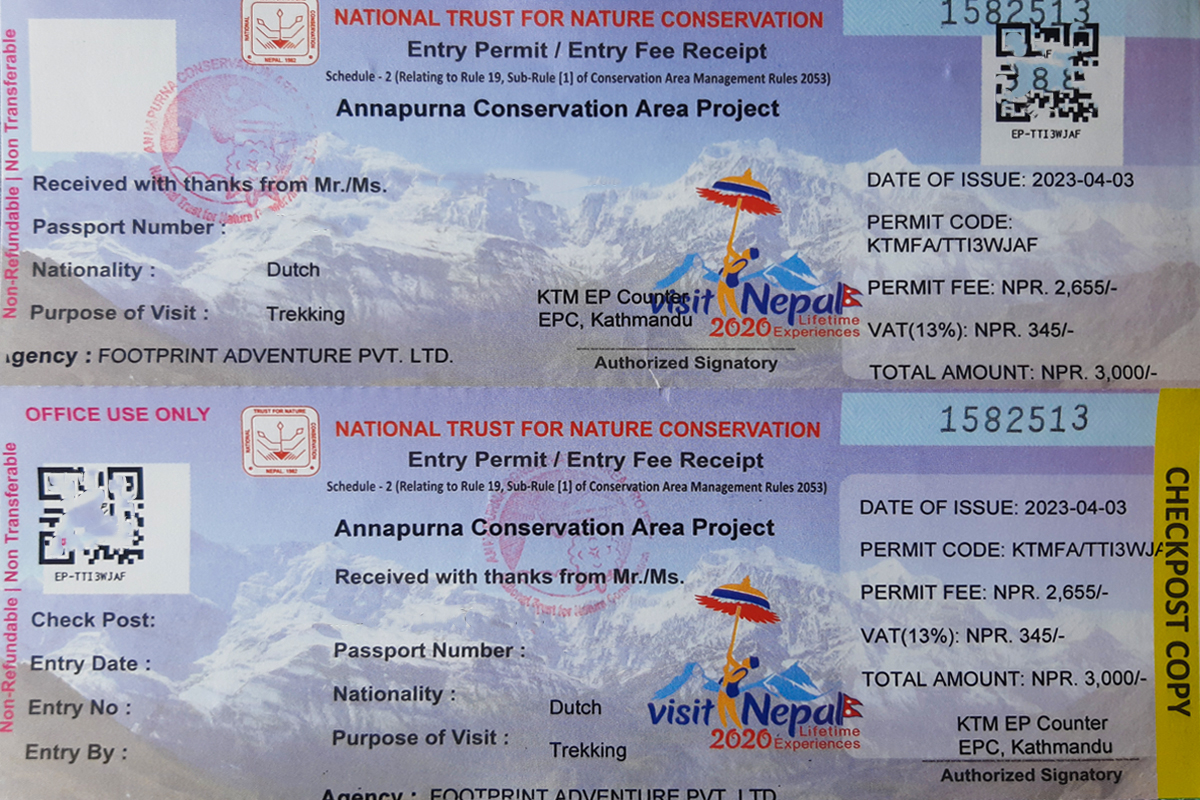
Rural Municipality Trekking Permit
A rural municipality trekking permit is a special permit given by the local administration of a rural municipality in Nepal that allows trekkers to enter and trek in the municipalities authorized zones. All trekkers who want to trek in Nepal's rural municipalities' administrative area must first acquire this permit.
The cost of the Rural Municipality Trekking Permit varies based on the particular municipality and the length of the trek, and is normally obtained through the local government office of the rural municipality. Trekkers in Nepal must additionally obtain a TIMS (Trekkers' Information Management System) card or a Trekking Agency Association of Nepal (TAAN) permit in addition to the Rural Municipality Trekking Permit to trek in the regions of Nepal.
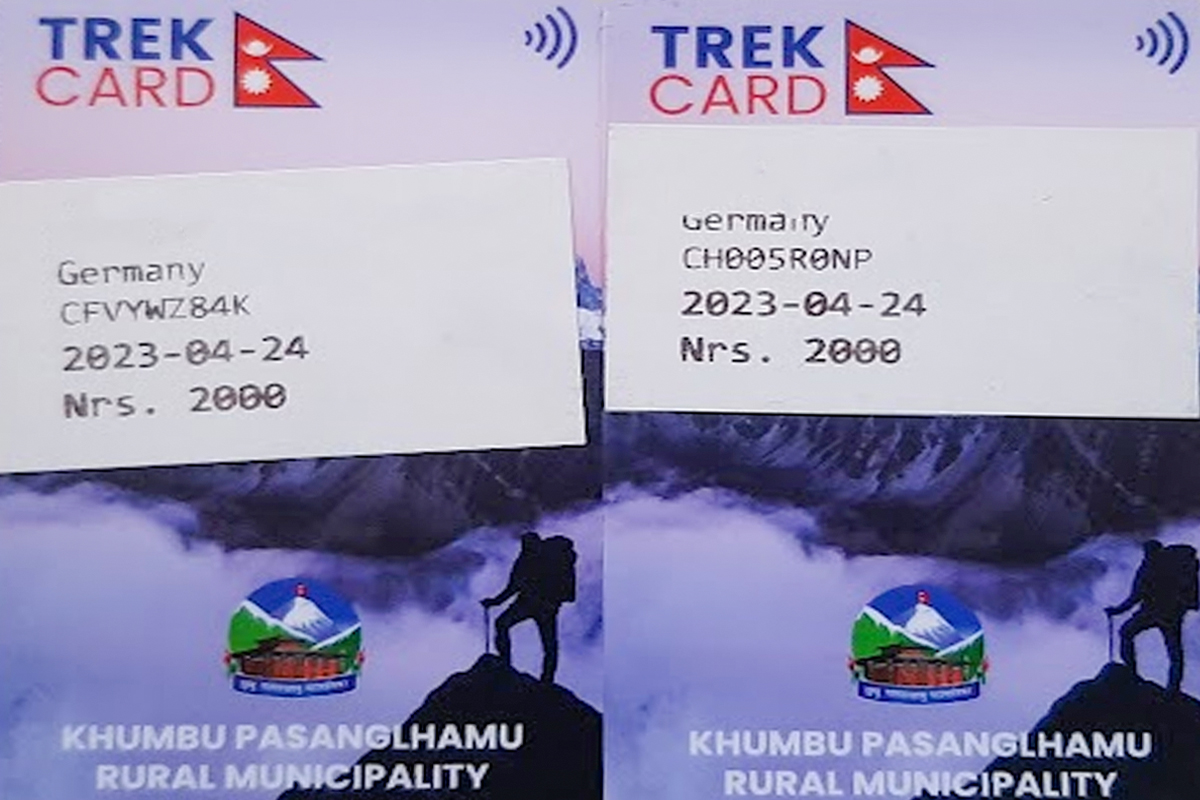
It is essential to note that distinct trekking routes in Nepal will require different permits, thus it is advised to research the specific permits required for your selected trek before leaving on your trek. Also, it is highly advised to hire a certified guide and/or porter for your trip in Nepal because they can offer essential assistance and support throughout your trek.
Personal documents requirement for Trekking Permits in Nepal
When booking a trek or tour in Nepal, we kindly request you to provide the following documents:
- A valid Passport or Travel Documents
- A valid passport copy
- A recent passport size photo
- Your contact details
- Complete documents of travel and health insurance
- Your Arrival Details and Departure flight Details
- Trekkers should respect local customs and traditions and must not indulge in any activity that goes against the established norms and culture of the society.
- Individual trekking in Restricted Areas is strictly forbidden. There should be a minimum of two trekkers.
- Daily remuneration, safety gears and appropriate clothes, Personal Accident insurance must be provided to Nepali citizens accompanying travel groups as guide/porter/any other supporting roles.
- Trekkers should trek only in the specified or designated route as per the Trekking Permit. They are not allowed to change routes. Or concerned trekking agency/trekking guide accompanying the group must not let trekkers change the route.
- Trekkers should comply with instructions given by authorized Officials in the trekking zone (Restricted Area).
- Mountaineers with expedition permits should get trekking permits as well if they have to pass through Restricted Areas to climb peaks. In this case, they do not need to pay fees for (Trekking) Permit.
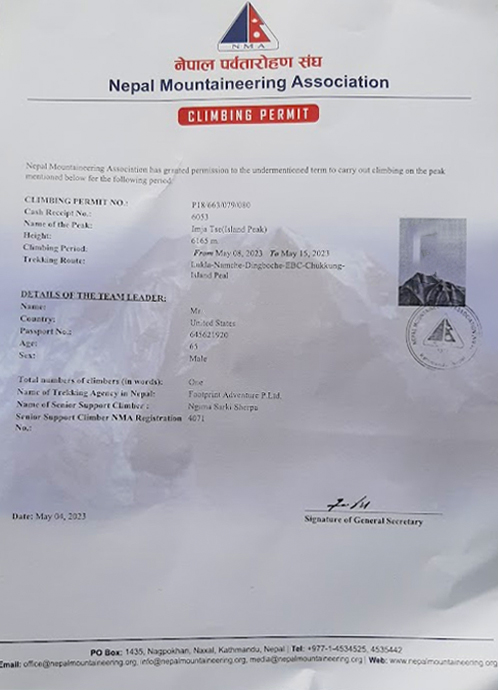
What documents are required for a trekking agency to obtain an entry permit for a restricted area?
The following documents must be submitted with an application for a restricted area trekking permit to the immigration office's department by authorized trekking companies.
- A photocopy of Valid Passport
- A photocopy of valid visa sufficient to cover trekking itinerary days
- Name lists of trekkers
- Program Schedule of trekking
- Guarantee letter of Agency
- Agreement with Agency
- Tax clearance Certificate of Trekking Agency
- Documents relating to insurance of the trekkers (foreign nationals) and Nepalese staff accompanying the trekkers
- License issued by The Ministry of Tourism, Culture and Civil Aviation to operate trekking business
- License issued by Nepal Rastra Bank allowing exchanging of foreign currencies
- The program schedule for trekking (Day wise itinerary)
- Registration Certificate of Permanent Account Number
- Voucher of Bank payment (fees) for permits
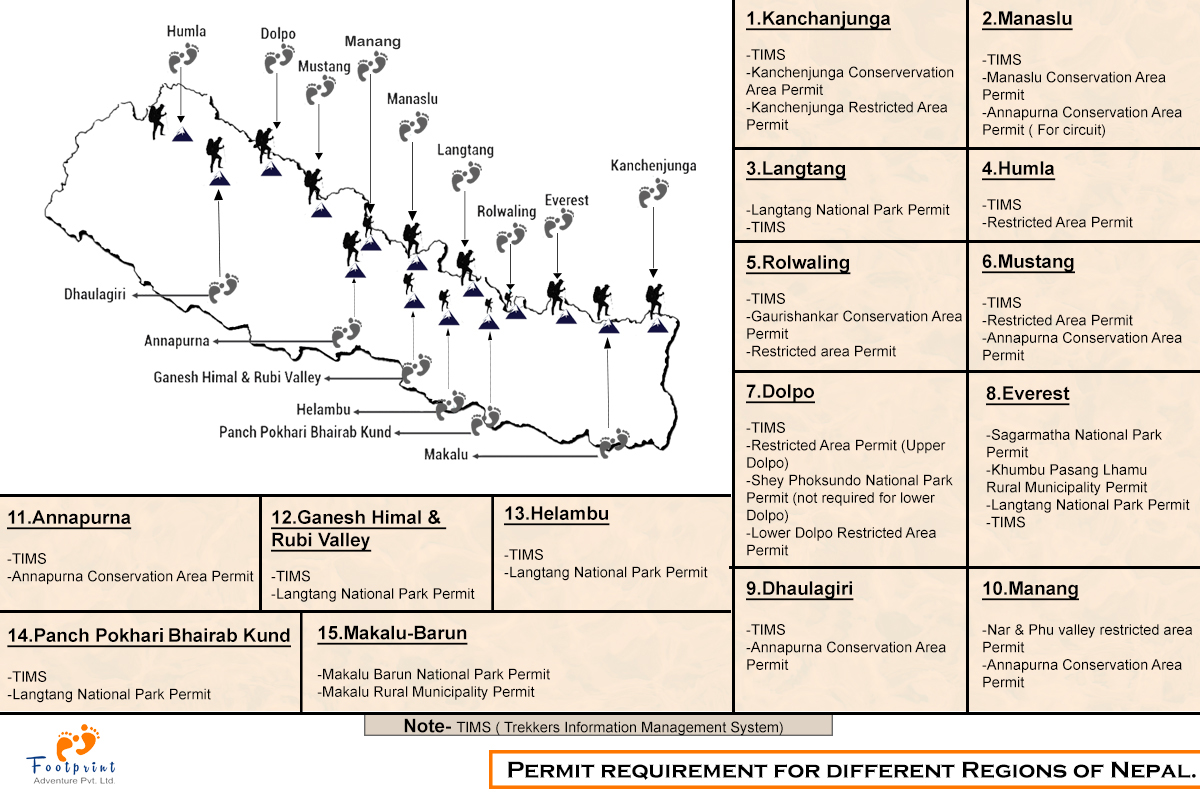
In conclusion, trekking in Nepal is an amazing experience that can provide adventurers with breathtaking views of the natural beauty of this magnificent country. Yet, it is important to obey the required permits and regulations to ensure safety and environmental protection. Here, Footprint Adventure is a leading trekking agency in Nepal that has been serving incredible trekking and traveling experiences throughout Nepal since 2015 and can help you with each and every permit requirement for your smooth and safe trekking experience in Nepal. At Footprint Adventure, we also believe that sustainable tourism is the key to preserving our natural beauty and promoting economic development in rural communities. Join us on a trek and experience the beauty of Nepal while leaving a positive impact on the environment. Contact us here, to plan your trekking adventure with Footprint Adventure.









